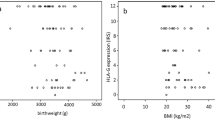We optimized the method of isolation of antibodies from placental tissue of a conventionally healthy patient. Four protocols of antibody isolation were evaluated and a protocol with tissue grinding (without homogenization) and successive elution of the antibodies with acidic and alkaline buffers was recommended for use. The repertoire of the isolated antibodies was characterized using a glycan array. Partial coincidence of the specificity of the isolated antibodies with antibodies in the peripheral blood was demonstrated, which indicates their possible association with carbohydrate antigens in the placenta. Identification of potential molecular targets of resident antibodies in the placenta is necessary for understanding the mechanisms of formation of immunological tolerance to the fetus.
Similar content being viewed by others
References
Barrientos G, Fuchs D, Schröcksnadel K, Ruecke M, Garcia MG, Klapp BF, Raghupathy R, Miranda S, Arck PC, Blois SM. Low levels of serum asymmetric antibodies as a marker of threatened pregnancy. J. Reprod. Immunol. 2009;79(2):201-210.
Faulk WP, Jeannet M, Creighton WD, Carbonara A. Immunological studies of the human placenta characterization of immunoglobulins on trophoblastic basement membranes. J. Clin. Invest. 1974;54(5):1011-1019.
Grennan DM, McCormick JN, Wojtacha D, Carty M, Behan W. Immunological studies of the placenta in systemic lupus erythematosus. Ann. Rheum. Dis. 1978;37(2):129-134.
Gu J, Lei Y, Huang Y, Zhao Y, Li J, Huang T, Zhang J, Wang J, Deng X, Chen Z, Korteweg C, Deng R, Yan M, Xu Q, Dong S, Cai M, Luo L, Huang G, Wang Y, Li Q, Lin C, Su M, Yang C, Zhuang Z. Fab fragment glycosylated IgG may play a central role in placental immune evasion. Hum. Reprod. 2014;30(2):380-391.
Khasbiullina NR, Shilova NV, Navakouski ME, Nokel AY, Knirel YA, Blixt O, Bovin NV. Repertoire of Abs primed by bacteria in gnotobiotic mice. Innate Immun. 2018;24(3):180-187.
Malan Borel I, Gentile T, Angelucci J, Pividori J, Guala M.C, Binaghi RA, Margni RA. IgG asymmetric molecules with antipaternal activity isolated from sera and placenta of pregnant human. J. Reprod. Immunol. 1991;20(2):129-140.
Roopenian DC, Akilesh S. FcRn: the neonatal Fc receptor comes of age. Nat. Rev. Immunol. 2007;7(9):715-725.
Zenclussen AC, Gentile T, Kortebani G, Mazzolli A, Margni R. Asymmetric antibodies and pregnancy. Am. J. Reprod. Immunol. 2001;45(5):289-294.
Author information
Authors and Affiliations
Corresponding author
Additional information
Translated from Byulleten’ Eksperimental’noi Biologii i Meditsiny, Vol. 167, No. 1, pp. 129-132, January, 2019
Rights and permissions
About this article
Cite this article
Ignat’eva, N.V., Ziganshina, M.M., Shilova, N.V. et al. Isolation of IgG Associated with Human Placenta. Bull Exp Biol Med 167, 120–122 (2019). https://doi.org/10.1007/s10517-019-04474-4
Received:
Published:
Issue Date:
DOI: https://doi.org/10.1007/s10517-019-04474-4




